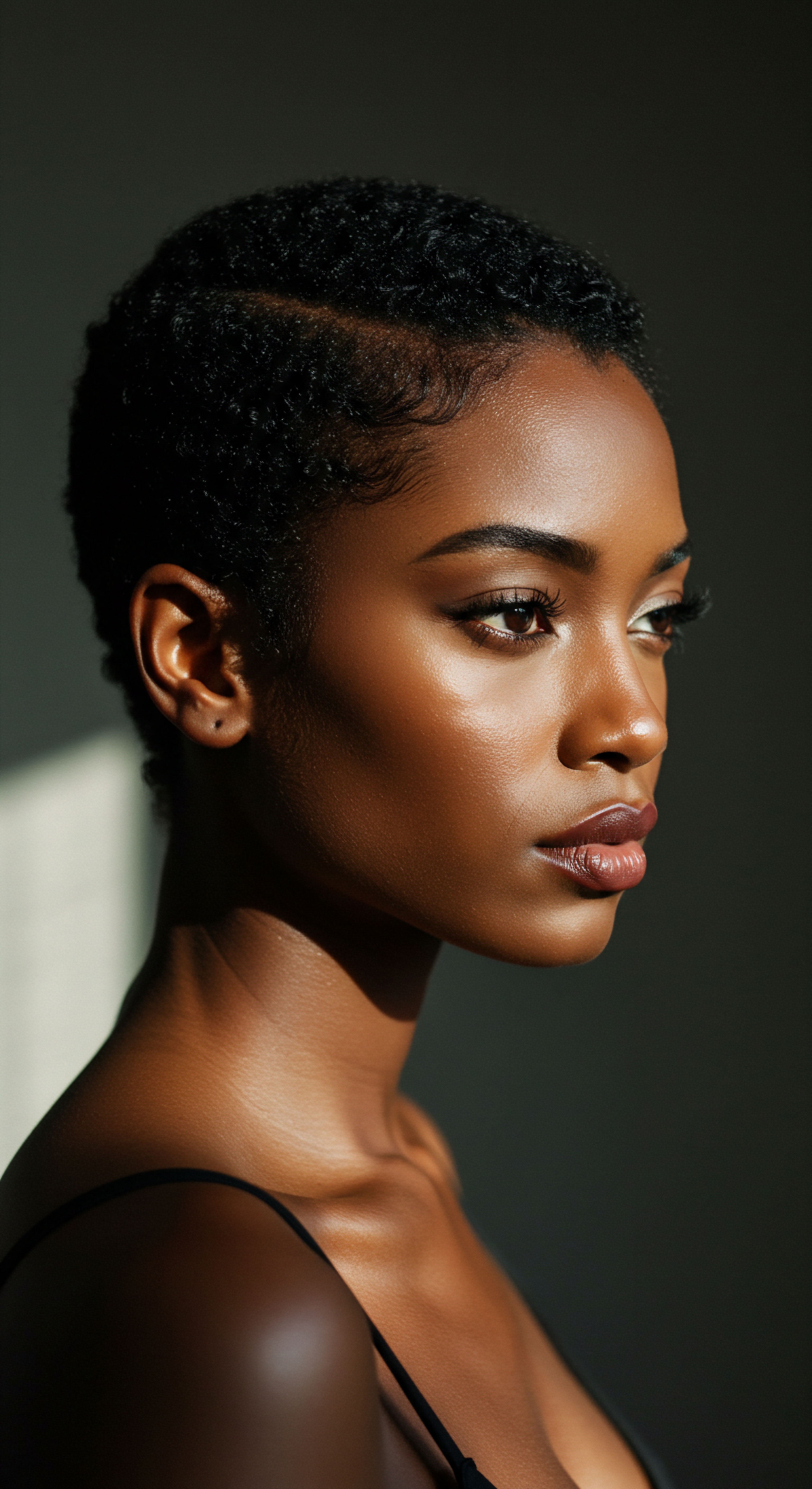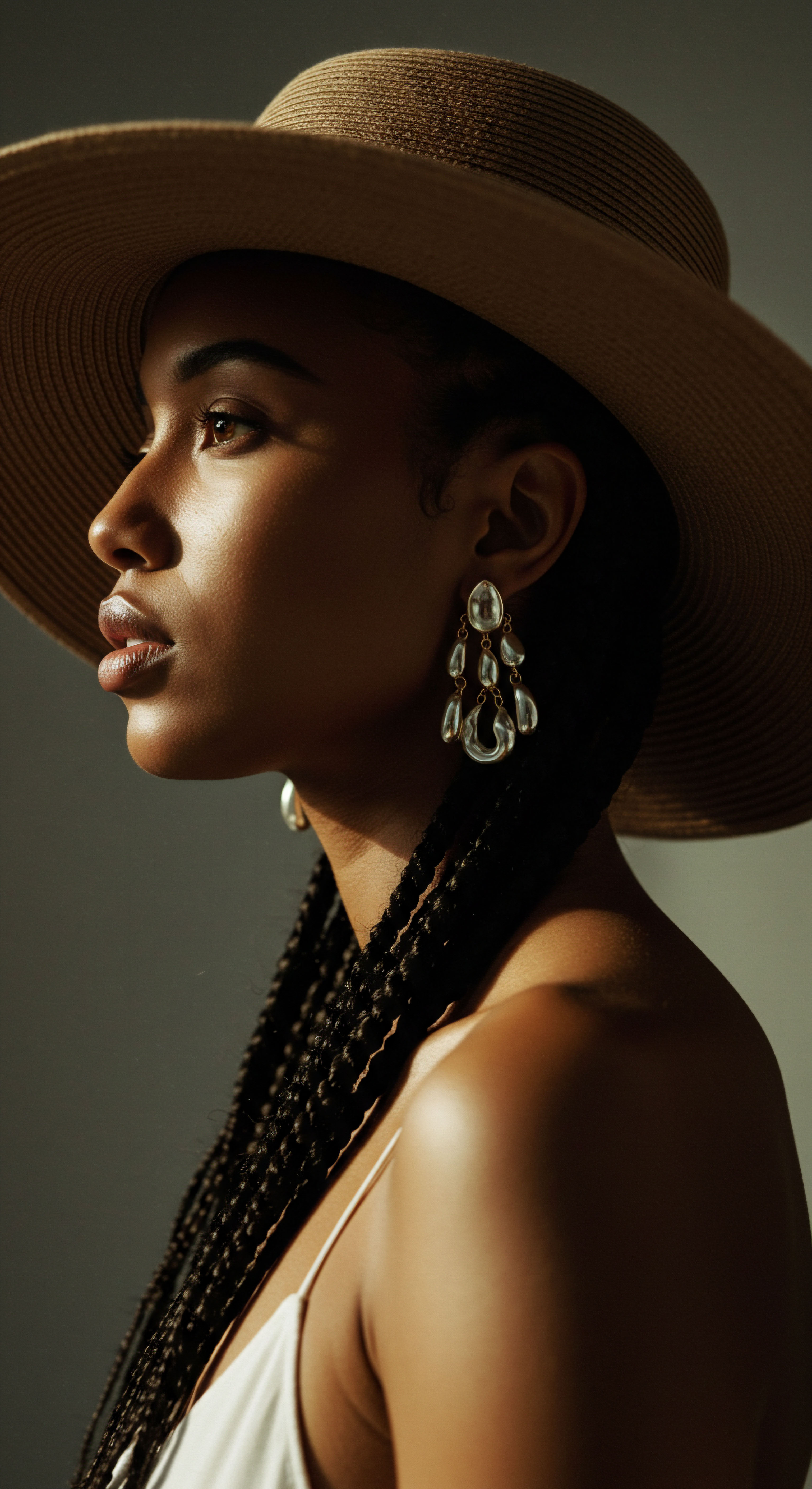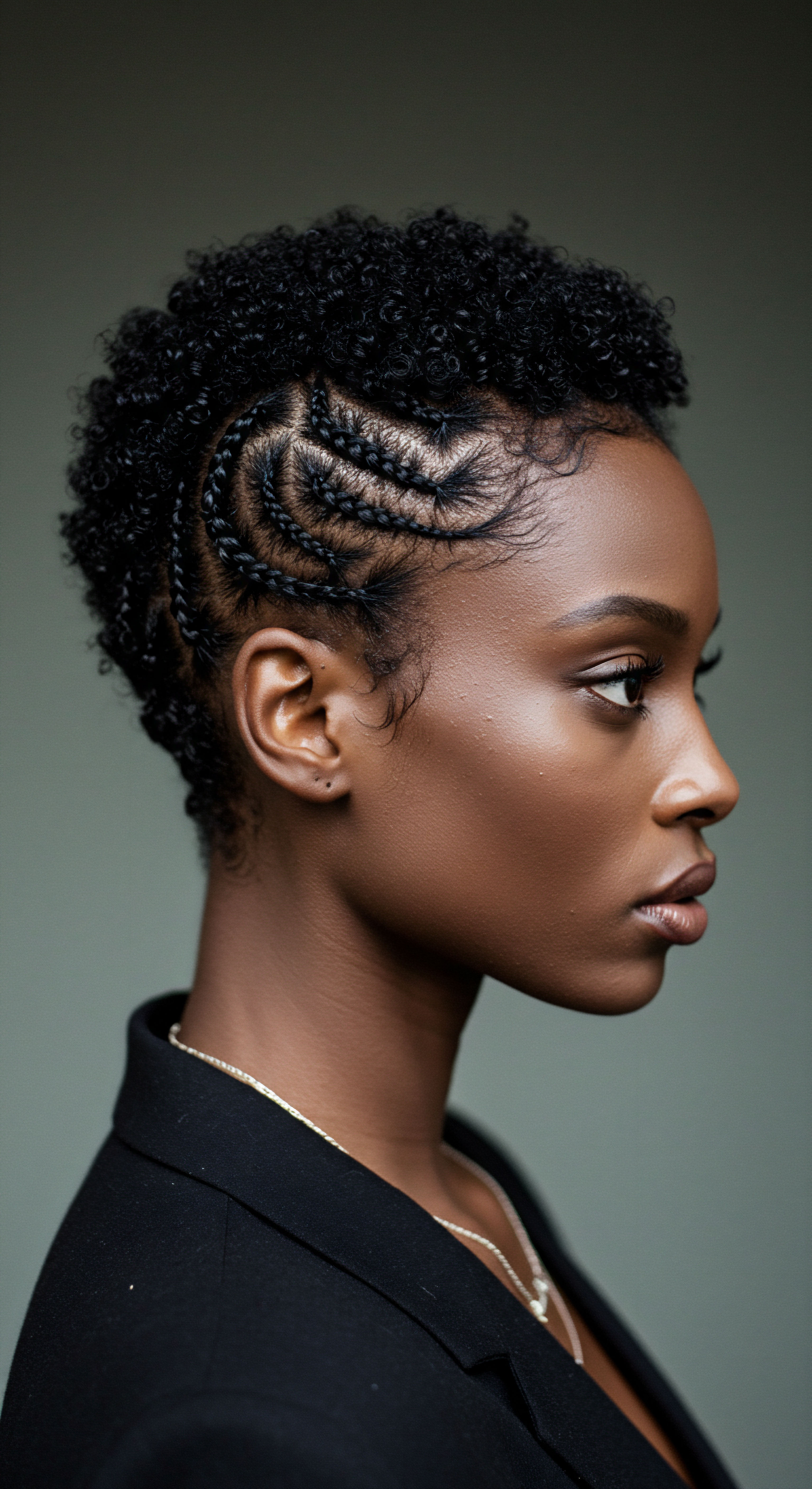
Roots
Our hair, a crown of self-expression and heritage, often holds stories far older than our own. When we consider how a bonnet helps textured hair retain its essential moisture, we begin a journey that extends beyond simple nightly routines. This understanding reaches into the very essence of hair structure, its unique needs, and the wisdom passed down through generations.
It is a quiet observation, perhaps, but one that opens a doorway to deeper care and a celebration of natural beauty. The question of a bonnet’s efficacy invites us to look closely at the foundational elements that allow textured strands to truly flourish.

What Makes Textured Hair Distinct
Textured hair, a term encompassing waves, curls, coils, and kinks, possesses a singular architecture that sets it apart. Unlike straight hair, the follicles that produce textured strands are often oval or flattened in shape. This distinctive follicular form contributes to the hair shaft’s spiral or zig-zag pattern as it grows.
This curvature, while beautiful, also means that the natural oils produced by the scalp, known as sebum, face a more challenging path traveling down the hair shaft. Consequently, textured hair often experiences greater dryness and can feel more delicate than its straighter counterparts.
A significant aspect of hair health lies within its outermost protective layer ❉ the cuticle. Picture the cuticle as a series of overlapping scales, similar to shingles on a roof. When these scales lie flat and smooth, they seal moisture within the hair’s core, known as the cortex, and reflect light, creating a lustrous appearance.
However, the natural bends and turns of textured hair can cause these cuticles to be more open or raised. This characteristic, often linked to higher porosity, means that while textured hair can readily absorb water, it can also lose that water just as quickly.
Textured hair, with its unique follicular shape and cuticle structure, is naturally more prone to dryness and moisture loss compared to straight hair.

How Does Hair Porosity Shape Moisture Retention?
Hair porosity describes the hair’s ability to absorb and hold onto moisture, a quality determined by the condition of its cuticle layer. Understanding your hair’s porosity is a foundational step in crafting an effective care regimen.
- Low Porosity Hair ❉ This hair type has tightly closed cuticle layers, making it resistant to water and products penetrating the hair shaft. While it takes time for moisture to enter, once absorbed, it tends to stay within the hair.
- Medium Porosity Hair ❉ With a balanced cuticle layer, this hair absorbs and retains moisture well, holding styles and hydration for several days.
- High Porosity Hair ❉ This hair type features a more open or compromised cuticle structure, allowing moisture to enter quickly but also escape with ease. Textured hair frequently exhibits higher porosity, making moisture retention a primary concern.
For individuals with high porosity hair, the challenge lies in sealing in the moisture after it has been absorbed. This often involves layering products, such as applying a liquid or leave-in conditioner, followed by an oil to seal the strands, and then a cream. This layering approach aims to create a barrier that helps prevent the rapid escape of hydration from the hair shaft.

Ritual
Stepping into the realm of practical wisdom, we find that the daily and nightly rituals we observe play a significant role in nurturing textured hair. The simple act of donning a bonnet before sleep is more than a habit; it is a deliberate choice, a gentle practice that speaks to an understanding of hair’s delicate needs during hours of rest. This ritual, deeply rooted in care and protection, offers a practical solution to the persistent challenge of moisture retention. It is here, in the quiet moments of preparing for sleep, that the bonnet begins its work, transforming the ordinary into a purposeful act of hair preservation.

Why Nighttime Protection Matters for Textured Hair
Sleep, often viewed as a time of passive rest, is in fact a period of active renewal for our entire body, including our hair. During these hours, hair can face significant environmental stressors. Traditional pillowcases, especially those made from cotton, are notoriously absorbent. They can draw moisture directly from hair strands, leading to dryness, brittleness, and a rough texture.
The friction generated by hair rubbing against coarse fabrics during tossing and turning can also cause physical damage, resulting in tangles, frizz, and breakage. This mechanical stress is particularly impactful for textured hair, which is already more prone to tangling and breakage due to its structural characteristics.
A consistent nighttime routine is therefore not merely about maintaining a style; it is about preserving the very integrity of the hair shaft. Prioritizing protective measures before bed creates an environment where hair can maintain its hydration and strength, allowing for a more serene awakening.

How Does a Bonnet Create a Protective Microclimate?
The bonnet acts as a personal sanctuary for hair during sleep, creating a distinct microclimate that supports moisture retention. The primary mechanism involves the material of the bonnet itself. Fabrics like silk and satin are favored for their smooth surfaces, which significantly reduce friction against hair strands. This smooth contact helps to keep the hair’s cuticle layers lying flat, preventing the lifting and damage that can lead to moisture loss and frizz.
A bonnet’s smooth material significantly reduces friction, safeguarding hair’s moisture and structural integrity during sleep.
Beyond friction reduction, bonnets help to create a sealed environment around the hair. This enclosed space minimizes the exposure of hair to the ambient air, particularly dry air, which can otherwise draw moisture from the strands through evaporation. By creating a barrier, the bonnet helps to trap the natural oils and any applied moisturizers close to the hair, allowing them to remain on the strands where they are most beneficial.
Consider the impact of humidity on hair. While high humidity can cause hair to swell and frizz due to excess moisture absorption, very dry air can lead to moisture loss, static, and brittleness. A bonnet helps to regulate this delicate balance, preventing extreme dryness by maintaining a consistent level of moisture around the hair. This localized humidity helps keep the hair supple and less susceptible to the damaging effects of environmental fluctuations.

Comparing Bonnet Materials for Moisture Retention
The choice of bonnet material directly influences its effectiveness in moisture retention.
| Material Type Silk |
| Friction Reduction High |
| Moisture Retention High |
| Breathability Moderate to High |
| Material Type Satin (Polyester) |
| Friction Reduction Medium to High |
| Moisture Retention Medium to Low |
| Breathability Low to Moderate |
| Material Type Bamboo |
| Friction Reduction High |
| Moisture Retention High |
| Breathability High |
| Material Type Cotton |
| Friction Reduction Low |
| Moisture Retention Very Low |
| Breathability High |
| Material Type Silk and bamboo are often considered superior for their combination of smoothness, moisture retention, and breathability. |
Silk Bonnets, made from natural protein fibers, are widely recognized for their exceptional smoothness and non-absorbent qualities. They allow hair to glide without friction, minimizing breakage and frizz, and are particularly effective at helping hair maintain its natural hydration. They also offer good temperature regulation.
Satin Bonnets, often crafted from synthetic materials like polyester, mimic silk’s smooth surface at a more accessible price point. While they significantly reduce friction compared to cotton and help with moisture retention, they may not offer the same level of breathability or moisture preservation as natural silk.
More recently, Bamboo Bonnets have emerged as a strong contender, offering a silky-smooth feel, excellent breathability, and temperature-regulating properties, along with being a sustainable choice.
Conversely, Cotton Pillowcases, a common sleeping surface, are highly absorbent and create considerable friction, actively drawing moisture from hair and leading to tangles and breakage. This stark contrast underscores the protective value of a bonnet.

Relay
Moving beyond the practicalities, the role of a bonnet in maintaining moisture for textured hair invites a deeper, more contextual exploration. It is a convergence of biological realities, historical echoes, and contemporary understanding. This piece of nightwear, seemingly simple, carries layers of meaning and function, standing as a quiet testament to a sustained effort in hair wellness. To truly appreciate its significance, we must consider the interplay of hair science, the wisdom of past generations, and the subtle environmental shifts that influence our strands.

Does the Bonnet’s Microclimate Truly Prevent Transepidermal Water Loss From Hair?
The concept of transepidermal water loss (TEWL) is commonly applied to skin, describing the passive diffusion of water through the epidermis into the surrounding air. While hair itself does not undergo TEWL in the same way skin does, the principles of moisture exchange with the environment remain highly relevant. Hair, especially textured hair with its often more open cuticle, is susceptible to losing water to drier ambient air through evaporation.
A bonnet creates a localized, humid microenvironment around the hair. By enclosing the hair within a smooth, non-absorbent fabric like silk or satin, the bonnet reduces the direct exposure of hair strands to the drier air of a bedroom. This action effectively lowers the vapor pressure gradient between the hair and its immediate surroundings, thereby slowing the rate at which water molecules escape from the hair shaft. This is particularly significant for textured hair, which, due to its unique structure and often higher porosity, is predisposed to moisture loss.
A study from TRI Princeton indicated that while hair immersed in water can increase cuticle step-height, leading to increased surface roughness and friction, some hydration can help reduce breakage for textured hair. The bonnet’s role is not to introduce excessive water, which can lead to over-hydration and potential breakage for some hair types, but rather to help maintain a balanced level of existing moisture, preventing extreme dryness. The smooth surface of the bonnet also helps to lay the cuticle flat, further sealing in hydration and reducing the potential for external moisture (like humidity) to cause frizz or damage.

How Does a Bonnet Reduce Mechanical Stress and Hygral Fatigue?
Beyond direct moisture preservation, bonnets offer critical protection against mechanical stress and hygral fatigue, issues that disproportionately affect textured hair.
Mechanical Stress ❉ During sleep, movement against rough surfaces like cotton pillowcases generates friction. This friction can lead to:
- Cuticle Damage ❉ The overlapping scales of the cuticle can lift, fray, or even break, compromising the hair’s protective barrier. This exposes the inner cortex to damage and accelerates moisture loss.
- Tangles and Knots ❉ Textured hair’s natural coils are prone to intertwining. Friction exacerbates this, leading to significant tangling and knotting that can be difficult and damaging to detangle in the morning.
- Breakage and Split Ends ❉ Repeated friction weakens the hair shaft, leading to breakage along the length and the formation of split ends, hindering length retention.
The smooth surface of a silk or satin bonnet minimizes this friction, allowing hair to glide freely. This reduction in mechanical stress directly translates to less cuticle damage, fewer tangles, and a significant decrease in breakage, preserving the hair’s structural integrity.
Hygral Fatigue ❉ This phenomenon refers to the damage caused by repeated swelling and de-swelling of the hair shaft as it absorbs and loses water. Hair swells in diameter when it absorbs water, and repeated cycles of this can weaken the hair’s internal structure, making it more prone to breakage. While moderate humidity can be beneficial for dry hair, excessive moisture absorption can lead to over-hydration and weakened strands.
The bonnet helps regulate the hair’s exposure to fluctuating humidity levels, particularly in environments where humidity can be inconsistent or excessively high. By creating a somewhat controlled microclimate, it helps to buffer the hair from drastic changes in moisture content, thereby mitigating the effects of hygral fatigue. This gentle, consistent environment supports the hair’s resilience, allowing it to maintain its elasticity and strength over time.
Beyond preserving moisture, bonnets shield hair from friction and rapid humidity shifts, protecting its structural integrity and reducing breakage.

Are Bonnets a Modern Iteration of Ancient Hair Protection?
The practice of covering hair for protection and preservation is not a recent innovation; it possesses deep historical and cultural roots, particularly within African communities. Long before the modern bonnet became a common sleep accessory, head coverings served multiple functions. In various African cultures, headwraps, known by names like ‘Dukus’ in Ghana or ‘Geles’ in Nigeria, were symbols of social status, marital standing, and cultural identity.
Beyond their symbolic significance, these coverings provided practical protection from the sun, dust, and dirt during daily activities. Critically, they also served to protect hair from environmental damage and to preserve hairstyles, a function directly paralleling the modern bonnet’s role. During the era of slavery, headwraps became a symbol of resistance and dignity for enslaved Black women, a way to preserve cultural identity amidst oppressive conditions, even when laws were passed to mandate their wearing as a sign of subservience.
This historical context grounds the contemporary use of bonnets in a legacy of hair care and cultural resilience. The bonnet, therefore, is not merely a piece of fabric; it is a continuation of an enduring practice, a tool that carries the weight of ancestral wisdom concerning hair health and preservation. The knowledge that textured hair benefits from protection, especially during periods of vulnerability like sleep, has been passed down, adapting in form but remaining constant in its purpose.
One striking example of this enduring practice is the observation that women in rural African communities have historically used headwraps not only for daily chores but also specifically during sleep to protect their hair. This highlights a long-standing understanding of the need for protective coverings during rest, directly preceding the widespread adoption of modern bonnets. The continuity of this practice underscores its efficacy and cultural significance, linking contemporary hair care to a rich, shared heritage of protecting and celebrating textured strands.

Reflection
Our exploration into the bonnet’s gentle influence on textured hair reveals a harmony of science, tradition, and thoughtful care. It speaks to the quiet power of small, consistent actions in nurturing something as personal as our hair. The understanding gained allows us to approach our routines not as burdens, but as acts of respect for our unique strands and the heritage they carry. As the sun sets and the bonnet finds its place, it becomes a silent promise of care, a tender shield for the vibrant life held within each curl and coil.

References
- TRI Princeton. (2024, April 18). Hair Moisturization Claims 101.
- UR Silk. (2024, November 26). A Complete Guide to Choosing the Perfect Nightcap/Bonnet.
- NYSCC. (2020, November 11). An Overview on Hair Porosity.
- The Silk Collection. Silk Bonnet vs. Satin Bonnet | Why Use Real Silk Bonnets | Silk Hair Bonnet.
- Noma Sana. (2025, January 2). Understanding Hair Porosity ❉ What It Means for Your Textured Hair.
- DiStefano Hair Restoration Center. (2025, March 7). Does Sleep Affect Hair Health?
- Obé Headwear. (2024, August 5). Significance of headwraps | Hair care.
- HairClub. 4 Reasons Your Pillowcase May Be Damaging Your Hair.
- Wilderness Safaris. (2015, January 25). The history & meaning of head wraps across Africa.
- Keswigs. Hair Cuticle and Hair Health.
- Reddit. (2023, May 4). Can hair acclimatize to humidity levels? Does it cause permanent damage?
- Josh Rose Brook. (2022, September 14). The Best Textured Hair Care Guide.
- Blissy. (2025, February 25). Best Silk Bonnet for Sleeping ❉ Why Silk Beats Satin for Hair.
- Florae Beauty. (2022, September 9). Understanding Hair Porosity and Density ❉ A Guide to Health Hair.
- JD Institute of Fashion Technology. (2021, June 23). HEADWRAPS ❉ HISTORY AND EVOLUTION.
- Cosmébio. (2024, February 23). Hydrating and Caring for Curly Textured Hair.
- Rest. Ditch Cotton Pillowcases | Best Pillow Cases for Better Skin and Hair.
- OZ Durag. (2024, October 9). What’s the Difference Between Silk and Satin Bonnets?
- Controlled Chaos. (2024, October 17). What Does Humidity Do to Curly Hair?
- Red Carpet Curls. The Science Behind Porosity & Naturally Textured Hair.
- Mukhaye. (2024, August 11). Why Understanding Your Cuticle Layer Can Help You Achieve Your Hair Goals.
- Crowned by Royalty. (2024, October 23). Satin Bonnets for Different Hair Types ❉ Are satin bonnets breathable?
- Crowned by Royalty. (2024, November 13). Satin Bonnets for Black Hair ❉ Benefits, Silk vs. Satin, and Protecting Natural Styles.
- The Independent. (2023, October 6). Does your pillowcase make a difference to your skin and hair health?
- Pattern Beauty. (2025, January 11). High Porosity Hair Care 101 ❉ A Complete Guide For Natural Textures.
- NAJEAU. Humidity’s Impact on Hair & Scalp.
- Olaplex. (2024, August 14). Why Is My Hair Different Textures?
- DZEE Home. (2024, July 15). Polyester Pillowcases ❉ Are They Good for Your Hair?
- L’Oréal Paris. (2022, August 17). How Does Sleep Affect Hair Health & Growth?
- Leone Culture. (2023, June 20). Exploring the Significance Of Headwraps In African Fashion And Traditions.
- Girl of a different Era. (2020, August 30). The History of Women’s Head Covering.
- MDPI. The Genomic Variation in Textured Hair ❉ Implications in Developing a Holistic Hair Care Routine.
- PreacherHead Ministries. The History of Headwraps Unwrapped.
- iican. (2024, September 30). The Importance of Sleep for Skin and Hair Health | I2CAN.
- Hairlust. (2025, April 2). The Truth About Silk Bonnets ❉ Why a Bamboo Hair Bonnet is Better.
- nylahs naturals. Your Guide To Hair Science And Hair Texture.